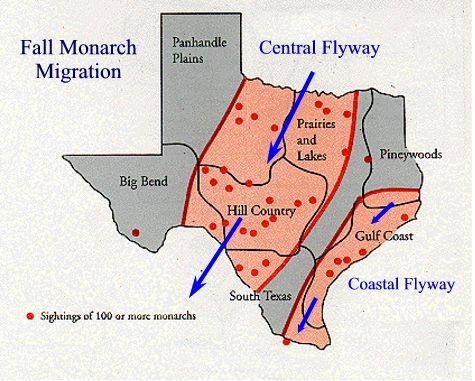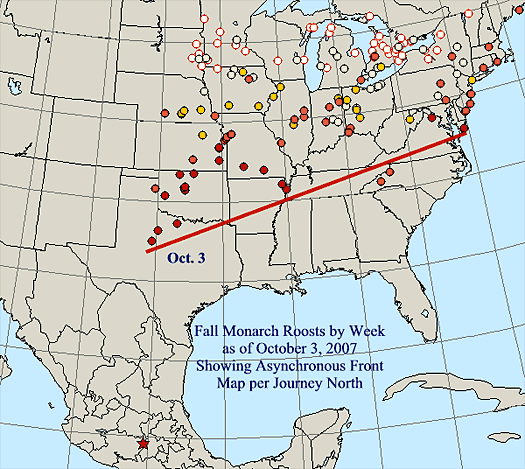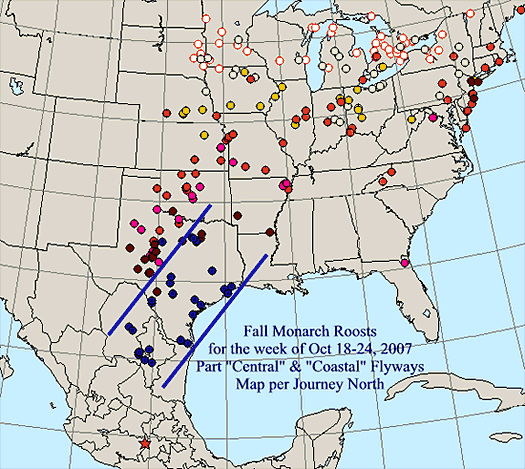2007: Unusual Migration & Hotter Than Normal Fall
Friday, January 18th, 2008 at 8:54 am by Jim LovettFiled under Monarch Migration | 3 Comments »
Tagging has shown that the timing and pace of the migration is generally quite predictable (see “Peak Migration Dates“). The pace of the migration was normal this year as the butterflies advanced from 50 degrees latitude in the north to about 40 degrees in the middle of the country – then the migration appeared to slow. The slowdown corresponded to a prolonged high-pressure system, with hot temperatures over the central portion of the country from late September through most of October.
As you know I’ve given myself the responsibility of trying to interpret monarch numbers on a year-round basis. This task is not difficult and most of the time I can articulate at least a general description of the relative size of the population and can usually explain why the numbers might be up or down. It’s pretty general stuff and subsequent events usually show that I’m not too far off the mark. There are challenges however, and this fall presented one such challenge. Monarch numbers appeared to be above normal once again in the east, although not as numerous as in 2006. Further, it was clear that the numbers of butterflies originating from the upper Midwest were greater than in 2006. Yet there were signs that the population coming through the central portion of the country was below the long-term average for this region.
The progression of the migration through both the central portion of the country and along the coast was unusual. In addition to a slowed migration as mentioned above, relatively low numbers of monarchs were reported from southern Minnesota through Oklahoma, with few exceptions. As this was happening, I was speculating that the monarchs were there but just weren’t being seen or reported. Due to the numbers of observers, much of the migration moves through the Midwest unreported in most years so this speculation seemed reasonable. The number of observers in Texas is much greater and I was expecting large numbers of monarchs to be reported as they moved through that state. It didn’t happen. In addition, the number of monarchs moving along the Gulf Coast from east Texas to Corpus Christi was one of the largest seen in decades.
Our understanding of what happened this fall was greatly enhanced by the efforts of Mike Quinn. Mike is an Invertebrate Biologist at Texas Parks & Wildlife and he has established a substantial network of professional and amateur naturalists that report monarch sightings during both the fall and spring migrations. Mike also marveled at the unusual nature of the monarch migration through Texas and the numerous observations and reports led him to post a summary of the sightings to Dplex-L, a Monarch Watch discussion list. Mike’s summary and analysis is represented below. The only note to add is that Monarch Watch received reports that large numbers of dead monarchs had washed ashore at Galveston and other locations along the coast or were seen flying over the Gulf, emphasizing the hazards of coastal travel.
Texas Monarch Watch – Compiled by Mike Quinn
Each fall, the majority of Texas monarch sightings consistently fall into what we call the Central and Coastal Flyways.Central (and larger) Flyway is generally most active from early to late October.
Conversely, the Coastal Flyway is generally active from mid October to mid November.
Question, are these flyways “real” and if so, why are they not synchronized?

Recapping the fall 2007 monarch migration.
Monarchs start heading south in late August.

By the first week in October, monarchs start crossing the Red River
The monarch front appears somewhat asynchronous at this time.

By mid October, monarchs pour through the Central Flyway.
This major monarch migration corridor generally extends from I-35 to Midland.

During the third week of October, the monarch flow appears to shift to the southeast.
At this time, monarchs occupy portions of the Central and Coastal Flyways.

By the last week of October, monarchs are primarily restricted to the Coastal Flyway.
The Coastal Flyway is more variable that the Central Flyway and is generally active from mid October to mid November.

The relative lack of monarch watchers across the southeastern U.S. contributes to the mystery of the origin of the coastal monarchs, but they likely started in the northeast.
If so, then the greater distance traveled from the northeast might account for the asynchronous timing of the Coastal Flyway, versus monarchs traveling a shorter distance from the Midwest and using the Central Flyway.
If the Coastal Flyway is populated by monarchs originating from the northeast, a potentially significant contributing factor to the delayed flight along this flyway may be the fact that winds rarely blow from the NE to the SW. Therefore, butterflies traveling such a route would encounter more cross winds than monarchs flying through the central flyway.
Some monarchs overwinter along the Gulf Coast. Is it possible that the impetus to continue migrating is lost due to the lateness of their arrival?
Concentrations of monarchs (shown in blue) seen along the Gulf Coast of Texas in late October 2007:
Monarch Roost map graphics created using Journey North‘s Fall 2007 Monarch Roost Maps



3 Responses to “2007: Unusual Migration & Hotter Than Normal Fall”
By Joe on Feb 23, 2008
I live in Northeastern PA (Pocono Mtn area), in the fall of 2007 I counted roughly 10 Monarchs fly through my area, which is a lot less than I have counted in previous years. I just wanted to let you know.
Thank you for the blog,
Joe
By Jerry N on Feb 27, 2008
I live south of Joe who reported on Feb 23rd.
Our watch area is in the Brandywine Valley, PA. By the fall of 2007 we had far fewer caterpillar’s than in last three years. In fall of 2006, I had more than I could count on my various milkweed plants. Thus, far fewer butterflies in late fall of 2007.
By Lisa W on May 17, 2008
I was out mowing around my milkweed today(May 17)and noticed a cat on one of my plants. Turns out I have 15 young cats. I have never seen them this early in the season-I live in central Indiana. What’s up? I did see one very faded monarch a couple of weeks ago but assumed it was a released one from a wedding..